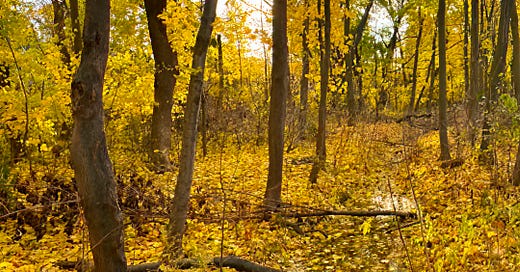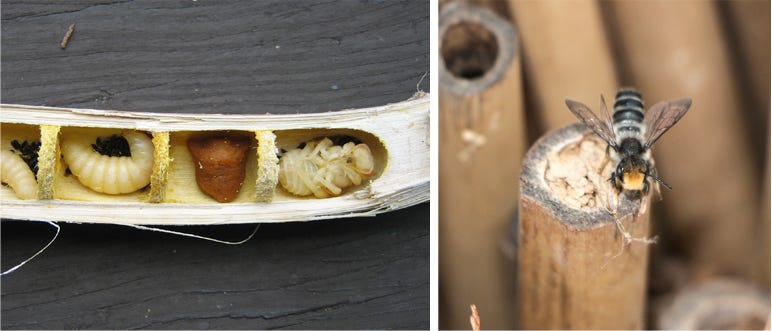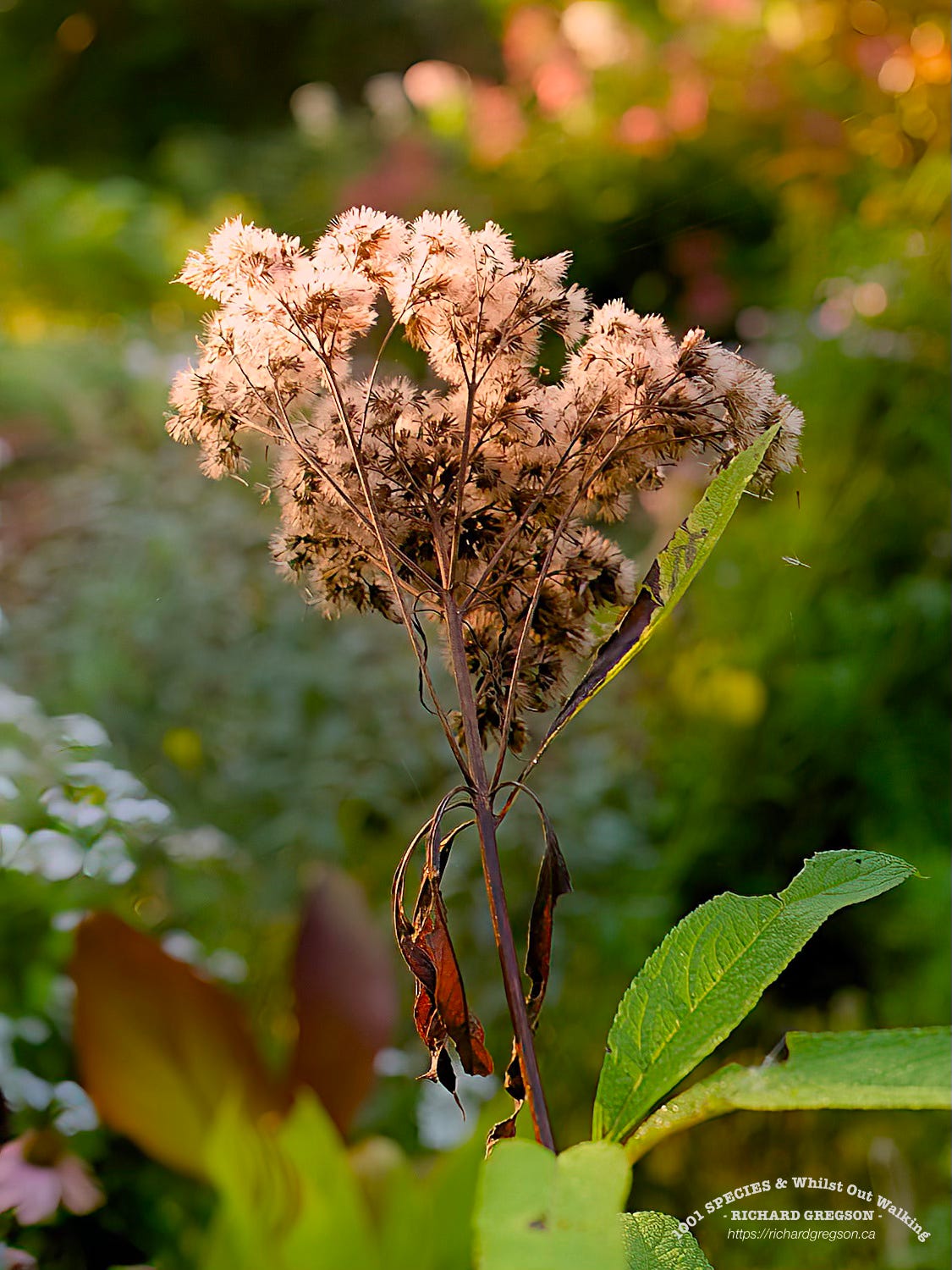Before getting down to gardening talk, this is to note that at around 7am on Friday morning, there was a huge southwards flight over the garden of hundreds of Common Grackles. Moving fast - it will be leaf-peeper season before too long.
Littering
This week my principle focus is on the wildlife garden in fall. My message, in a nutshell, being that there is no need to be quite so tidy while waiting for the first snowfall as we assume the neighbours would like us to be. Almost everyone says that they enjoy the bees and butterflies in their summer gardens and many comment on the fact that there are fewer and fewer of them as each year passes. To have butterflies or bumble bees in summer it is necessary to protect the places that they need to get through the cold months. They don’t just magically reappear from out of nowhere. We must manage the habitat for which we are responsible in a way that helps them make it through winter.
It is that season again when we remember to leave the stems, seed heads, and leaf litter alone and to resist any atavistic urges our upbringing may have engendered for excessive tidiness. Wildlife gardeners know that our native plant gardens are something more than lawn and border gardens — they are habitat that we have created and manage as a gift to nature. Long after the whirs, flutters, and buzzes have vanished with the summer, our native perennials, shrubs, trees, and leaves are still hard at work.
The problem, may be calling these initiatives “rewilding” in the first place. That implies ceding control to nature. What’s going on here is more “habitat restoration”, a more managed process where humans can still call the shots.
Stephen Carver, professor of rewilding and wilderness science at the University of Leeds
Although you usually cannot see them*, in the fallen leaves, tree bark, old logs, soil and dried seed heads of our gardens if we have not done the traditional neat-nick tidying beloved of past generations, there is a complex community of animals out there that has evolved with an ability to survive our cold winters. Depending on where you live this could include centipedes, spiders, beetles, earthworms, slugs and moth pupae and there could also be frogs, salamanders, and snakes. It all depends on the soil and on the ground cover above it throughout the winter.
[*note: “Although you usually cannot see them …” unless you are like me and enjoy grubbing about at ground level, or unless you are like the average five year old who revels in this sort of investigation. Taking five year olds into the garden and turning over logs to show them stuff can be quite rewarding for all concerned.]
Within a few inches of the soil's surface, there are insects in a state called diapause that remain dormant until the ground warms in spring. The entomologist, Doug Tallamy, notes that in autumn, an estimated 94 percent of moths drop off the trees they have inhabited as larvae, land under the cover of leaves, bark and soil and pupate in cocoons to wait out the winter ready to emerge as adults during the following spring. If we clean away all that leaf litter we deny all those creatures the chance of living and reproducing in the next year … and then we complain that there are many fewer moths and butterflies etc “these days”. The answer to that is in our own hands.
Leaf litter also helps some amphibians that are not overwintering in the bottom of a pond to retain moisture levels and provides protection. Reptiles also seek shelter.
Most of our suburban mammals also hibernate or at least enter torpor as the world gets cold. Chipmunks, voles and other small rodents might seek shelter in open logs or small burrows, insulating any gaps and holes with plant material such as milkweed seed fibres. Bigger mammals, like groundhogs and foxes, build dens, not moving much at all for months.
Your garden, if you let it winter naturally, is not dead in the cold. It sustains a host of creatures if you only leave those leaf piles, flower stalks and other debris in place. Many of your flowers will enter winter as dead, dried stems retaining life in their subsurface parts, but they have enormous value for small insects - not forgetting that if they have seed heads on top then those are essential for the birds that spend winter beside us. The Xerxes Society note the following:
Many hollow or pithy plant stems and branches provide excellent places for cavity-nesting insects to call home. Small carpenter bees (Ceratina spp.) frequently carve out their nests in last year’s dead raspberry (Rubus spp.) canes or wildflower stems, often only a few inches away from the blossoms that provide pollen to feed their young. Still tinier yellow-faced bees (Hylaeus spp.) use the hollow center of smaller stems, like bee balm (Monarda spp.) or roses (Rosa spp.), and larger leaf-cutter bees (Megachile spp.) prefer the larger stems of plants like native thistles (Cirsium spp.), cup plant (Silphium perfoliatum), or desert willow (Chilopsis linearis). Other common occupants of dead stems and twigs include cavity-nesting wasps, stem-boring moths, and even some spiders. In addition, some beneficial insects insert their eggs into the stems of wildflowers and grasses for safe keeping over the winter.
How to manage the garden for insects in winter
This graphic is from the Xerxes Society - it suggests a seasonal ideal. (note: it’s in two columns, don’t read across and down like a page of text)
Here is a protocol that is easy to follow - in essence it suggests that you do pretty much what the “tidy” gardener has always done, BUT at different times of the year.
In the autumn/fall let leaves lie for the most part or else rake them. Spread what you can as a mulch on flower beds and around trees, put the rest on the compost heap. Leave the stems of dead perennials to stand , especially those with seed heads on top for the winter birds to enjoy. Relax.
In spring, when the snows have melted, and air temperatures are starting to rise, you can start carefully clearing those dried stems. Cut them off a few inches above the ground and stack them in a sheltered corner so that any emerging insects still inside the stems have a chance of surviving. Wait until summer before disposing of them.
Leave the leaf mulch on the flower borders - consider raking any leaves on an area of lawn onto the mulched areas. Insect activity and worms will see to mixing the organic materials with the soil as the months progress.
… and that’s it. As the world starts to green-up again next spring you will have something for your neighbours to admire.
Interesting read - especially if you live in the UK
This link is to an article that appeared a couple of days ago about the parlous state of Britain’s National Parks. As a teenager, back in the sixties, together with friends, we would escape to the Yorkshire Dales NP at weekends as an escape from the city. It was wonderful, but now …
Quote: At that time, farming was far less intensive than it was to become. It had helped shape the countryside over centuries, creating important cultural heritage. But as the decades passed, sheep and cattle grazing intensified, assisted by chemical fertilisers and pesticides, and peatlands were drained and burned, with devastating consequences for nature. But the national parks had no power to prevent the damage inside their boundaries. “So you have the situation today, where a national park authority can dictate what kind of window someone has on their house, but not control what happens on large tracts of land where activities would be really damaging to the natural environment”. National parks were designed for a different, long-gone era.












Timely and informative -- thank you!
Thanks! Am saving this for future reference.